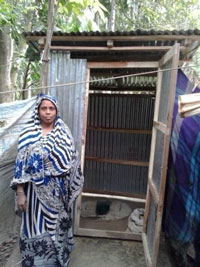Bangladesh - Sealing Leaky Pits
Sealing Leaky Pits: One Small Doable Action at a Time
Zannat Begum has lived in Khaspara village, one of WASHplus’s rural intervention communities, since she was married 15 years ago. Her husband is a fisherman and spends most of his time away from home like the majority of the men in the neighborhood. At part of its planning process, WASHplus conducted a community situation analysis in Khaspara and identified several poor sanitation practices.
Most of the latrines in the area traditionally drained into canals or ponds to avoid the need for cleaning/desludging by hand, but this practice contaminates open water sources. Since the analysis, this practice has started to change. 
Zannat and her neighbors learned about the risk of diarrhea due to leaching latrines during a mother’s group session and is now the proud owner of a newly rehabilitated latrine. Many other leaky pits in the community have been sealed to prevent feces from contaminating open water.
One of Zannat’s neighbors was unable to buy rings and slabs for her latrine and instead built a robust structure out of bamboo, wood, and plastic sacks. Although the latrine does not meet all the criteria of an improved facility, this “small doable action” approach has stopped the practice of open defecation.
Zannat says, “Many families in the community did not have latrines, and among those who had a functional latrine, most of those had leaching cracks in the pits. When the outreach staff explained to us the diagram of feces transmission and said having cracks in the pits is similar to defecating in the open, we all agreed to mend the pits.” She adds, “I have three daughters and if mending this crack brings good health and growth to them, why would I not do that?”
This is one example of how WASHplus and its local implementing partner WaterAid are working in targeted, hard-to-reach, marginalized communities in Bangladesh to improve sanitation status not only by promoting fixed point defecation but also by gradually moving households up the sanitation ladder toward more hygienic feces management.

